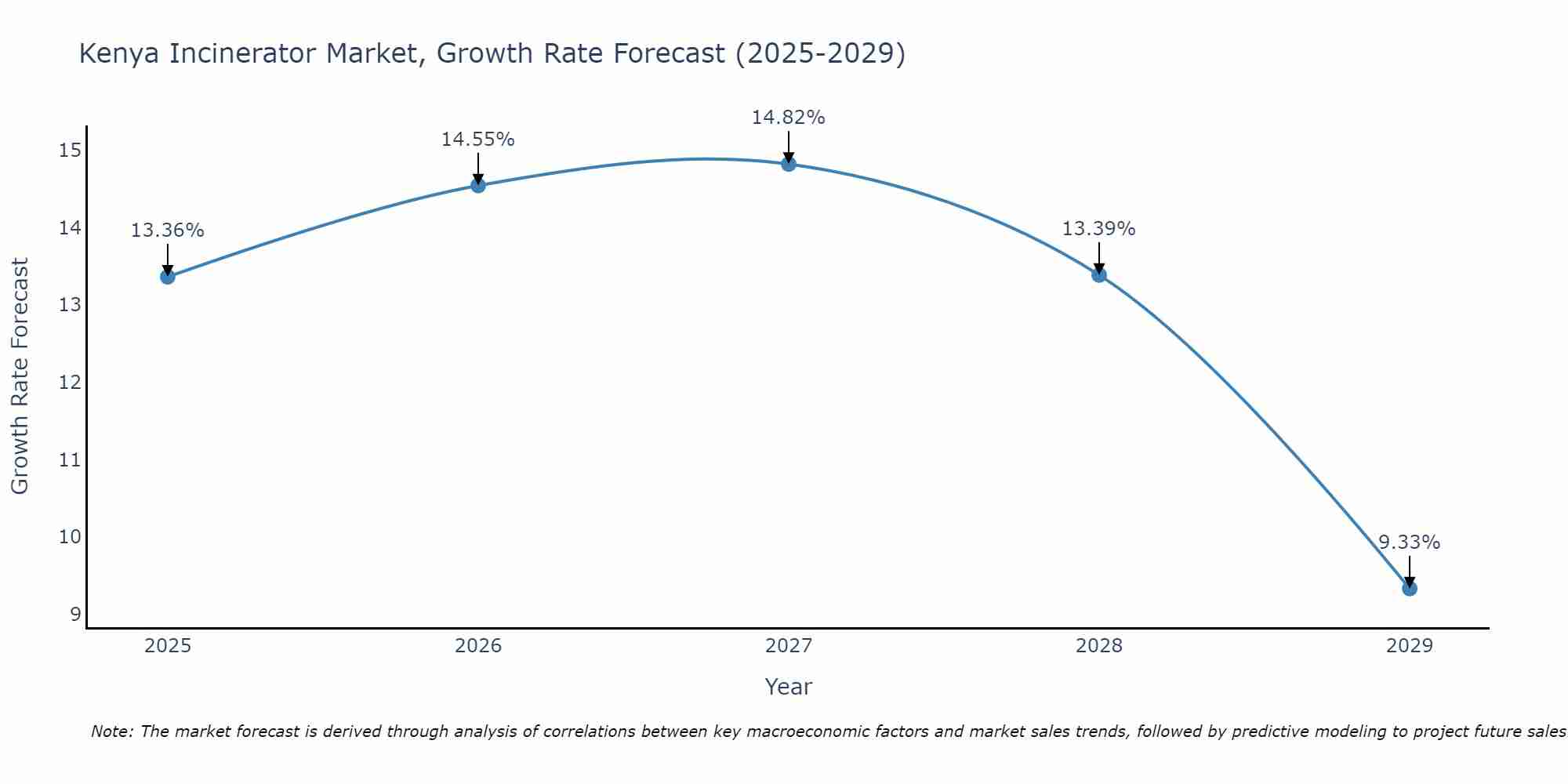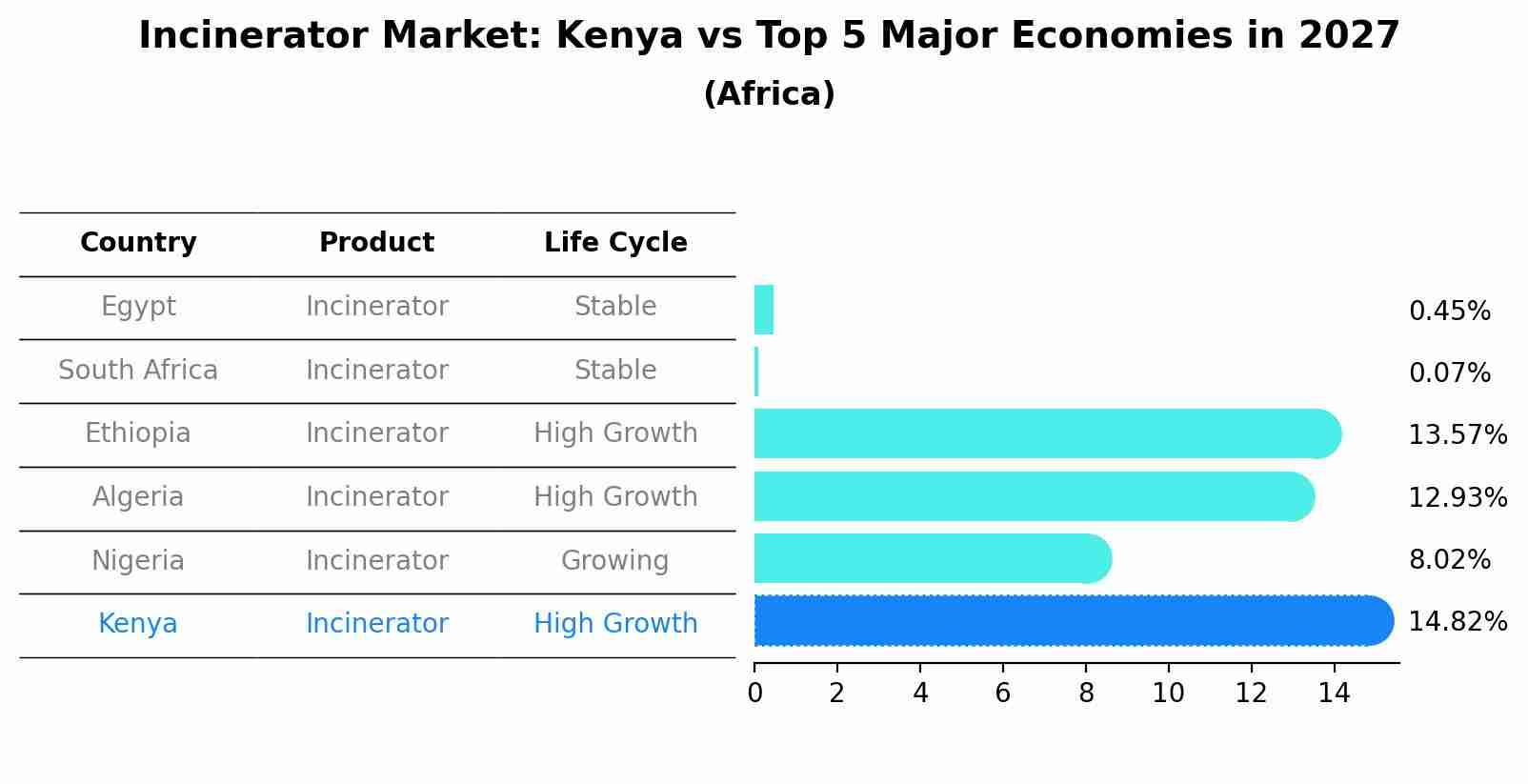Kenya Incinerator Market Outlook | Companies, Industry, Share, Revenue, Growth, Value, Forecast, COVID-19 IMPACT, Analysis, Trends & Size
| Product Code: ETC130183 | Publication Date: Jun 2021 | Updated Date: Jun 2025 | Product Type: Report | |
| Publisher: 6Wresearch | Author: Sachin Kumar Rai | No. of Pages: 70 | No. of Figures: 35 | No. of Tables: 5 |
Kenya Incinerator Market Size Growth Rate
The Kenya Incinerator Market is projected to witness mixed growth rate patterns during 2025 to 2029. Growth accelerates to 14.82% in 2027, following an initial rate of 13.36%, before easing to 9.33% at the end of the period.

Incinerator Market: Kenya vs Top 5 Major Economies in 2027 (Africa)
The Incinerator market in Kenya is projected to grow at a high growth rate of 14.82% by 2027, within the Africa region led by Egypt, along with other countries like South Africa, Ethiopia, Algeria and Nigeria, collectively shaping a dynamic and evolving market environment driven by innovation and increasing adoption of emerging technologies.

Kenya Incinerator Market Overview
The Kenya incinerator market is experiencing growth driven by increasing awareness of environmental protection and waste management needs in the country. The market is characterized by a rising demand for incinerators across various sectors such as healthcare, municipal solid waste management, and industrial applications. Key factors influencing market growth include government initiatives to promote sustainable waste management practices, rapid urbanization leading to increased waste generation, and a growing focus on reducing landfill usage. The market is witnessing a shift towards advanced incinerator technologies that offer higher efficiency, lower emissions, and better environmental compliance. Key players in the Kenya incinerator market are focusing on product innovation, strategic partnerships, and expansion of their distribution networks to capitalize on the growing demand for incineration solutions in the country.
Kenya Incinerator Market Trends
In the Kenya incinerator market, there is a notable trend towards the adoption of more environmentally friendly and sustainable incineration technologies. This shift is driven by increasing awareness of the environmental impact of traditional incineration methods and regulations aimed at reducing emissions and promoting cleaner energy sources. As a result, there is a growing demand for incinerators that utilize advanced combustion techniques, such as air pollution control systems and energy recovery systems, to minimize harmful emissions and maximize energy efficiency. Additionally, there is a focus on developing incinerators that can handle a wide range of waste materials, including medical, industrial, and municipal waste, to meet the diverse needs of various sectors in Kenya. Overall, the market is witnessing a move towards more efficient, sustainable, and versatile incineration solutions.
Kenya Incinerator Market Challenges
In the Kenya Incinerator Market, some of the key challenges include limited awareness and understanding of the benefits of incineration technology among potential users, especially in rural areas where traditional waste disposal methods are still predominant. Additionally, the high initial investment cost of incinerators can be a barrier for smaller businesses and municipalities looking to adopt this technology. Inadequate waste segregation practices and inconsistent enforcement of regulations related to waste management also contribute to the challenges faced in the market. Furthermore, concerns about air pollution and emissions from incineration facilities present a regulatory and public acceptance challenge that needs to be addressed for the sustainable growth of the incinerator market in Kenya.
Kenya Incinerator Market Investment Opportunities
Investment opportunities in the Kenya incinerator market are promising due to the increasing focus on waste management and environmental sustainability in the country. With a growing population and urbanization, there is a rising need for efficient waste disposal solutions, making incinerators a key technology. Investors can capitalize on this trend by providing advanced incinerator technologies that comply with environmental regulations and offer cost-effective waste management solutions. Additionally, partnerships with local municipalities and waste management companies can create opportunities for long-term contracts and steady revenue streams. Investing in the Kenya incinerator market not only aligns with the country`s sustainability goals but also presents a chance for financial growth in a burgeoning sector.
Kenya Incinerator Market Government Policy
The Kenya government has implemented policies to regulate the incinerator market to manage waste and reduce environmental pollution. The National Environment Management Authority (NEMA) oversees the incinerator sector, ensuring compliance with environmental standards and guidelines. The government has also encouraged the use of environmentally friendly incinerators that meet emission standards and promote sustainable waste management practices. Additionally, there are regulations in place to monitor the disposal of incinerator ash and other by-products to prevent adverse impacts on public health and the environment. Overall, government policies in Kenya aim to promote responsible waste management practices within the incinerator market while safeguarding environmental quality and public health.
Kenya Incinerator Market Future Outlook
The Kenya Incinerator Market is expected to witness steady growth in the coming years due to increasing environmental concerns, rising urbanization, and the need for proper waste management solutions. The government`s initiatives to promote sustainable waste disposal practices, coupled with the growing healthcare sector and stricter regulations on waste disposal, are driving the demand for incinerators in the country. Additionally, technological advancements in incinerator systems, such as improved efficiency and reduced emissions, are further fueling market growth. With a focus on addressing waste management challenges and promoting a cleaner environment, the Kenya Incinerator Market is poised for expansion and is likely to attract investments from both domestic and international players in the near future.
Key Highlights of the Report:
- Kenya Incinerator Market Outlook
- Market Size of Kenya Incinerator Market, 2021
- Forecast of Kenya Incinerator Market, 2027
- Historical Data and Forecast of Kenya Incinerator Revenues & Volume for the Period 2018 - 2027
- Kenya Incinerator Market Trend Evolution
- Kenya Incinerator Market Drivers and Challenges
- Kenya Incinerator Price Trends
- Kenya Incinerator Porter's Five Forces
- Kenya Incinerator Industry Life Cycle
- Historical Data and Forecast of Kenya Incinerator Market Revenues & Volume By Product Type for the Period 2018 - 2027
- Historical Data and Forecast of Kenya Incinerator Market Revenues & Volume By Moving Grate for the Period 2018 - 2027
- Historical Data and Forecast of Kenya Incinerator Market Revenues & Volume By Static Hearth, Furnace and Multiple Hearth for the Period 2018 - 2027
- Historical Data and Forecast of Kenya Incinerator Market Revenues & Volume By Rotary Kiln for the Period 2018 - 2027
- Historical Data and Forecast of Kenya Incinerator Market Revenues & Volume By Fluidized Bed for the Period 2018 - 2027
- Historical Data and Forecast of Kenya Incinerator Market Revenues & Volume By End-user for the Period 2018 - 2027
- Historical Data and Forecast of Kenya Incinerator Market Revenues & Volume By Municipal Sector for the Period 2018 - 2027
- Historical Data and Forecast of Kenya Incinerator Market Revenues & Volume By Industrial Sector for the Period 2018 - 2027
- Kenya Incinerator Import Export Trade Statistics
- Market Opportunity Assessment By Product Type
- Market Opportunity Assessment By End-user
- Kenya Incinerator Top Companies Market Share
- Kenya Incinerator Competitive Benchmarking By Technical and Operational Parameters
- Kenya Incinerator Company Profiles
- Kenya Incinerator Key Strategic Recommendations
Frequently Asked Questions About the Market Study (FAQs):
Kenya Incinerator |
1 Executive Summary |
2 Introduction |
2.1 Key Highlights of the Report |
2.2 Report Description |
2.3 Market Scope & Segmentation |
2.4 Research Methodology |
2.5 Assumptions |
3 Kenya Incinerator Market Overview |
3.1 Kenya Country Macro Economic Indicators |
3.2 Kenya Incinerator Market Revenues & Volume, 2021 & 2027F |
3.3 Kenya Incinerator Market - Industry Life Cycle |
3.4 Kenya Incinerator Market - Porter's Five Forces |
3.5 Kenya Incinerator Market Revenues & Volume Share, By Product Type, 2021 & 2027F |
3.6 Kenya Incinerator Market Revenues & Volume Share, By End-user, 2021 & 2027F |
4 Kenya Incinerator Market Dynamics |
4.1 Impact Analysis |
4.2 Market Drivers |
4.3 Market Restraints |
5 Kenya Incinerator Market Trends |
6 Kenya Incinerator Market, By Types |
6.1 Kenya Incinerator Market, By Product Type |
6.1.1 Overview and Analysis |
6.1.2 Kenya Incinerator Market Revenues & Volume, By Product Type, 2018 - 2027F |
6.1.3 Kenya Incinerator Market Revenues & Volume, By Moving Grate, 2018 - 2027F |
6.1.4 Kenya Incinerator Market Revenues & Volume, By Static Hearth, Furnace and Multiple Hearth, 2018 - 2027F |
6.1.5 Kenya Incinerator Market Revenues & Volume, By Rotary Kiln, 2018 - 2027F |
6.1.6 Kenya Incinerator Market Revenues & Volume, By Fluidized Bed, 2018 - 2027F |
6.2 Kenya Incinerator Market, By End-user |
6.2.1 Overview and Analysis |
6.2.2 Kenya Incinerator Market Revenues & Volume, By Municipal Sector, 2018 - 2027F |
6.2.3 Kenya Incinerator Market Revenues & Volume, By Industrial Sector, 2018 - 2027F |
7 Kenya Incinerator Market Import-Export Trade Statistics |
7.1 Kenya Incinerator Market Export to Major Countries |
7.2 Kenya Incinerator Market Imports from Major Countries |
8 Kenya Incinerator Market Key Performance Indicators |
9 Kenya Incinerator Market - Opportunity Assessment |
9.1 Kenya Incinerator Market Opportunity Assessment, By Product Type, 2021 & 2027F |
9.2 Kenya Incinerator Market Opportunity Assessment, By End-user, 2021 & 2027F |
10 Kenya Incinerator Market - Competitive Landscape |
10.1 Kenya Incinerator Market Revenue Share, By Companies, 2021 |
10.2 Kenya Incinerator Market Competitive Benchmarking, By Operating and Technical Parameters |
11 Company Profiles |
12 Recommendations |
13 Disclaimer |
- Single User License$ 1,995
- Department License$ 2,400
- Site License$ 3,120
- Global License$ 3,795
Search
Thought Leadership and Analyst Meet
Our Clients
Related Reports
- Afghanistan Apparel Market (2026-2032) | Growth, Outlook, Industry, Segmentation, Forecast, Size, Companies, Trends, Value, Share, Analysis & Revenue
- Canada Oil and Gas Market (2026-2032) | Share, Segmentation, Value, Industry, Trends, Forecast, Analysis, Size & Revenue, Growth, Competitive Landscape, Outlook, Companies
- Germany Breakfast Food Market (2026-2032) | Industry, Share, Growth, Size, Companies, Value, Analysis, Revenue, Trends, Forecast & Outlook
- Australia Briquette Market (2025-2031) | Growth, Size, Revenue, Forecast, Analysis, Trends, Value, Share, Industry & Companies
- Vietnam System Integrator Market (2025-2031) | Size, Companies, Analysis, Industry, Value, Forecast, Growth, Trends, Revenue & Share
- ASEAN and Thailand Brain Health Supplements Market (2025-2031) | Strategy, Consumer Insights, Analysis, Investment Trends, Opportunities, Growth, Size, Share, Industry, Revenue, Segments, Value, Segmentation, Supply, Forecast, Restraints, Outlook, Competition, Drivers, Trends, Demand, Pricing Analysis, Competitive, Strategic Insights, Companies, Challenges
- ASEAN Bearings Market (2025-2031) | Strategy, Consumer Insights, Analysis, Investment Trends, Opportunities, Growth, Size, Share, Industry, Revenue, Segments, Value, Segmentation, Supply, Forecast, Restraints, Outlook, Competition, Drivers, Trends, Demand, Pricing Analysis, Competitive, Strategic Insights, Companies, Challenges
- Europe Flooring Market (2025-2031) | Outlook, Share, Industry, Trends, Forecast, Companies, Revenue, Size, Analysis, Growth & Value
- Saudi Arabia Manlift Market (2025-2031) | Outlook, Size, Growth, Trends, Companies, Industry, Revenue, Value, Share, Forecast & Analysis
- Uganda Excavator, Crane, and Wheel Loaders Market (2025-2031) | Strategy, Consumer Insights, Analysis, Investment Trends, Opportunities, Growth, Size, Share, Industry, Revenue, Segments, Value, Segmentation, Supply, Forecast, Restraints, Outlook, Competition, Drivers, Trends, Demand, Pricing Analysis, Competitive, Strategic Insights, Companies, Challenges
Industry Events and Analyst Meet
Whitepaper
- Middle East & Africa Commercial Security Market Click here to view more.
- Middle East & Africa Fire Safety Systems & Equipment Market Click here to view more.
- GCC Drone Market Click here to view more.
- Middle East Lighting Fixture Market Click here to view more.
- GCC Physical & Perimeter Security Market Click here to view more.
6WResearch In News
- Doha a strategic location for EV manufacturing hub: IPA Qatar
- Demand for luxury TVs surging in the GCC, says Samsung
- Empowering Growth: The Thriving Journey of Bangladesh’s Cable Industry
- Demand for luxury TVs surging in the GCC, says Samsung
- Video call with a traditional healer? Once unthinkable, it’s now common in South Africa
- Intelligent Buildings To Smooth GCC’s Path To Net Zero


















